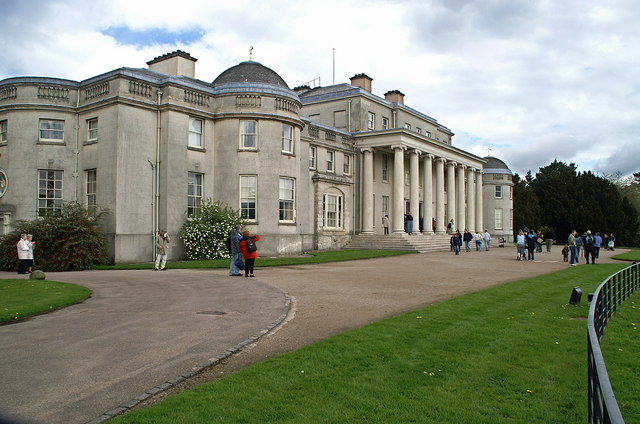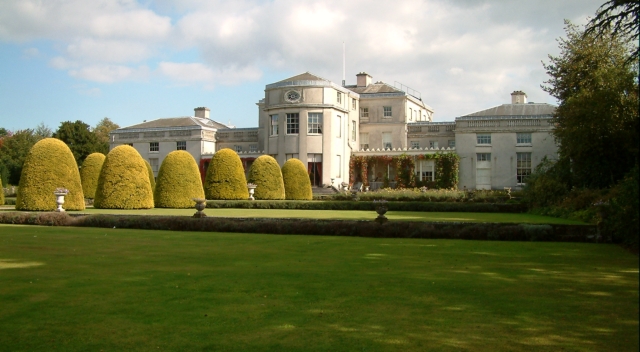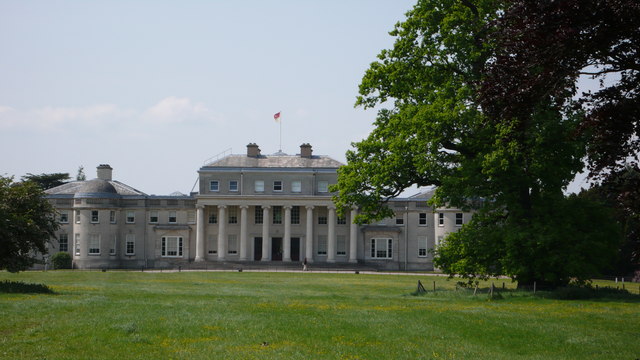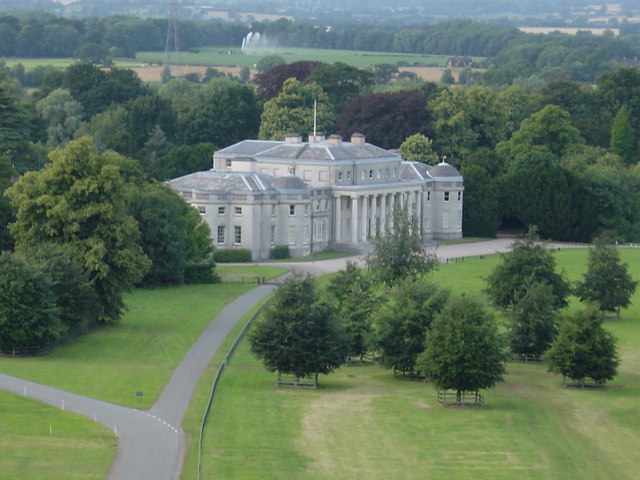
Shugborough Hall, Staffordshire
Photo © Richard Styles, 1 May 2005

Shugborough Hall, Staffordshire
Photo © Graham Taylor, 29 September 2007

Shugborough Hall, Staffordshire
Photo © Calum McRoberts, 24 May 2008
 Shugborough Hall, Staffordshire Photo © Richard Styles, 1 May 2005 |
 Shugborough Hall, Staffordshire Photo © Graham Taylor, 29 September 2007 |
 Shugborough Hall, Staffordshire Photo © Calum McRoberts, 24 May 2008 |
Shugborough is a country estate in Great Haywood, Staffordshire, England, 4 miles from Stafford on the edge of Cannock Chase. It comprises a country house, kitchen garden, and model farm. Owned by the National Trust and maintained by the leaseholder, Staffordshire County Council, it previously belonged to the Earls of Lichfield, the Anson family.
The house was enlarged around 1750 under the architect James "Athenian" Stuart, who also created a number of follies and monuments in the grounds. These include the Tower of Winds (based on one in Greece), the Chinese House (a Chinese-style pagoda), a triumphal arch based on Hadrian's, a Doric Temple, the Cat's Monument, and the Shepherd's Monument.
The entire estate was remodelled at the turn of the 19th century, under Thomas Anson, the 1st Viscount Anson and his wife Anne Margaret Coke, daughter of Thomas Coke, the 1st Earl of Leicester, whom he married in 1794. Styled Viscountess Anson in 1806, Anne Margaret Coke Anson died in London in 1843 and was buried at Shugborough.
The grounds are connected to the village of Great Haywood by the Essex Bridge, built in the Middle Ages, and contain numerous sculptures in addition to Stuart's follies.
Nearby is Milford Hall, the estate of the Levett Haszard family, who are related to the Ansons and who sit on the board at Shugborough.[1]
The Anson family purchased the estate in the 17th century from Thomas Whitby of Great Haywood, Staffordshire. The family produced some famous men, including George Anson, 1st Baron Anson, George Anson (British soldier), General George Anson (1769-1849), Thomas Anson (MP), Dean of Chester Frederick Anson and his sons George Edward Anson and Frederick Anson, Canon of St George's Chapel at Windsor Castle. Seven ships in the Royal Navy have been christened HMS Anson, honouring the first Baron Anson's circumnavigation in the 1740s.
The house contains a collection of photographs by the house's recent resident, the royal photographer, the late Patrick Anson, 5th Earl of Lichfield, who died in 2005. Lichfield was the first cousin, once removed, of Queen Elizabeth II of the United Kingdom, his mother Anne Bowes-Lyon (1917-1980) having been a niece of Elizabeth Bowes-Lyon, the late Queen Mother. Anne Anson subsequently divorced, and upon remarriage became Princess Anne of Denmark.
Her son, Patrick Anson, was divorced from Leonora Anson, Countess of Lichfield, daughter of Robert Grosvenor, 5th Duke of Westminster. The Countess has retained her title despite the divorce and she has not remarried.
The Shepherd's Monument has been internationally well-known since 1982, when the book The Holy Blood and the Holy Grail drew attention to the mysterious Shugborough inscription. Carved by an unknown 18th-century craftsman, this has been called one of the world's top uncracked ciphertexts.[2] Theories have abounded, including some which suggest it may indicate the whereabouts of the Holy Grail, an idea fuelled by the Anson family's ancestral ties to the Knights Templar. In recent years, codebreakers from the National Codes Center at Bletchley Park in Buckinghamshire have tried unsuccessfully to decipher it. Before them, it is said that Charles Darwin and Charles Dickens also tried, and similarly failed.
Numerous explanations have been put forward, linking the code to the Priory of Sion, the Holy Grail and UFO's. One more modest and romantic theory being that of a secret message between two lovers.[3]
J. R. R. Tolkien, author of The Lord of the Rings, stayed in Great Haywood during the winter of 1916/17 and in his story 'The Tale of the Sun and the Moon' (The Book of Lost Tales 1) he writes about a gnome called Gilfanon who owned an ancient house "...the House of a Hundred Chimneys, that stands nigh the bridge of Tavrobel". Tavrobel he describes a village near the confluence of two rivers. If you stand on the Essex Bridge, you can see where the river Sow meets the river Trent; and Shugborough Hall has about 80 chimneys.
Another fantasy author, Mark Chadbourn, features Shugborough and the mysterious bas-relief on the Shepherd's Monument in his novel The Hounds of Avalon, part of The Dark Age sequence. In the novel, the gardens provide a point of access to the magical Otherworld of Celtic mythology.
Nicolas Poussin's Arcadia and the inscription also figure prominently in the fiction work by Steve Berry, The Alexandria Link. They are used to find the location of the Library of Alexandria.

Shugborough Hall, Staffordshire
Photo © Mandy Moore, 13
July 2004
The grounds and mansion house are open to the public and include a working model farm museum dating from 1805 complete with a working watermill, kitchens, a dairy, a tea room, and rare breeds of farm animals. The walled garden, also dating from 1805, was restored in 2006 and is also open to the public.
The house contains the historic servants' quarters, and within these, a brewhouse. Restored in 1990, this is England's only log-fired brewery that still produces beer commercially. It has been open to the public on certain weekends since 2007.
Most of Wikipedia's text and many of its images are licensed under the
Creative Commons Attribution-ShareAlike 3.0 Unported License (CC BY-SA)
![]()